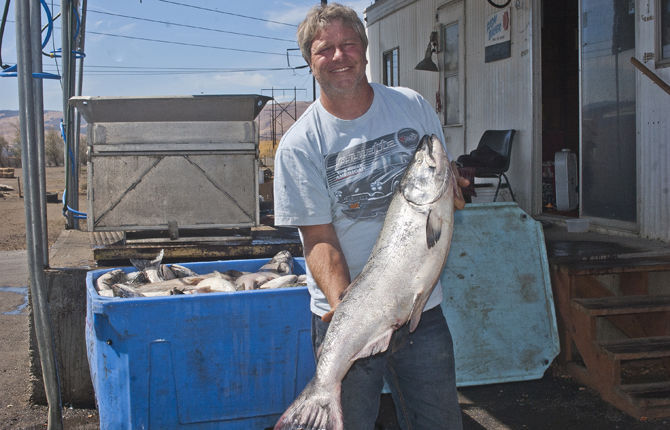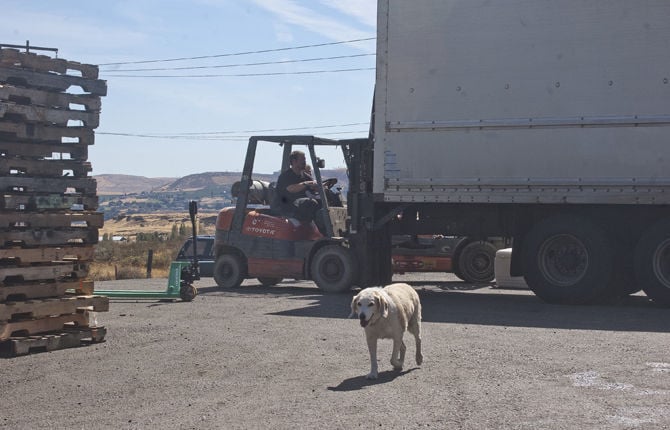There are some very large fish being unloaded this week at Gilmore Fish Smokehouse, located at 167 Highway 197, near Dallesport.
Tribal fisherman have their gill nets out for fall Chinook salmon, the catch has been good, and smokehouse manager Jim Olheiser is buying fish five days a week.
“Fresh fish is the biggest part of the business,” Olheiser said. “The smokehouse keeps us going in the off-season.”
The off-season isn't so long as it used to be, he noted. From May through October, salmon and steelhead make up the catch. There are more fish in recent years, said Olheiser, who has been buying fish for Gilmore for 20 years. Coho, sockeye, Chinook. The runs are better, with more fish available to the Native American fishermen. “20 years ago, we didn't have a spring season,” he added.
In February, sturgeon come in season, although unlike salmon sturgeon numbers have dropped over the years. “We buy maybe 20,000 pounds a year,” Olheiser said. “There are fewer every year.”
Over a full year, he will buy a million pounds of fish. Most of it will be processed for the fresh fish market on site: Gilmore operates five days a week, with a crew of six or seven employees.
The Smokehouse was started by Roy Gilmore in 1985, with his wife Tommie Gilmore. His daughters, Robin Bratton and Lee “Ann” Olhieser, helped with the work and are co-owners of the smokehouse today.
Bratton was only 16 years old when she moved with her family from Longview Wash., to the Dallesport area. “We had an all girl crew our first year,” she laughed, made up of her sister and her friends and family. “It's a family business, for sure.”
During the season, Gilmore processes 30,000 pounds of fish each day. All are purchased directly from Native American fishermen working the Columbia River.
Twenty years ago, Gilmore was one of only two fish buyers on the river. Today, there are 15 or 20 fish buyers working the river.
The biggest impact has been on prices, said Jim Olheiser. “Prices have doubled, tripled, quadrupled. That's the biggest change. That's been good for the fishermen, of course.”
“There is a lot of competition now for the fish,” he explained. “We make phone calls, we pay extra. We're lucky, because we have some very loyal fishermen that we've been working with for years.” The number of fisherman he works with varies between 20 and 40, averaging perhaps 25.
After processing, the fish are sold wholesale to buyers in Los Angeles and Portland. The fish are then retailed to stores and restaurants. “We take them to Portland, they bring them back up the river,” he laughed.
Between seasons and in the winter, business turns to the smokehouse.
“We sell at bazaars, as holiday gifts,” he explained.
The smoked fish are classified as “hot smoked,” but unlike most smoked fish, which is made with a combination of heat and smoke applied over an extended period of time, these fish are cold smoked in a refrigerated unit for 36 hours, then baked in an old pizza oven gleaned from an old pizza shop.
The result is a juicier smoked fish. “Heat draws the moisture off,” Olheiser said.
“Since we only cook them for one and one-half hours, they lose less moisture,” he explained.
The smoked fish are then sealed in packages for sale.
Local buyers can purchase the smoked salmon at the small retail outlet under the Gilmore Fish Smokehouse sign off Highway 197, next to the fish processing facility.
There are no set hours, but it truly is a family business: Park at the little smokehouse market and if Bratton doesn't come out to see what you need, her mother Tommie Gilmore will.










Commented
Sorry, there are no recent results for popular commented articles.